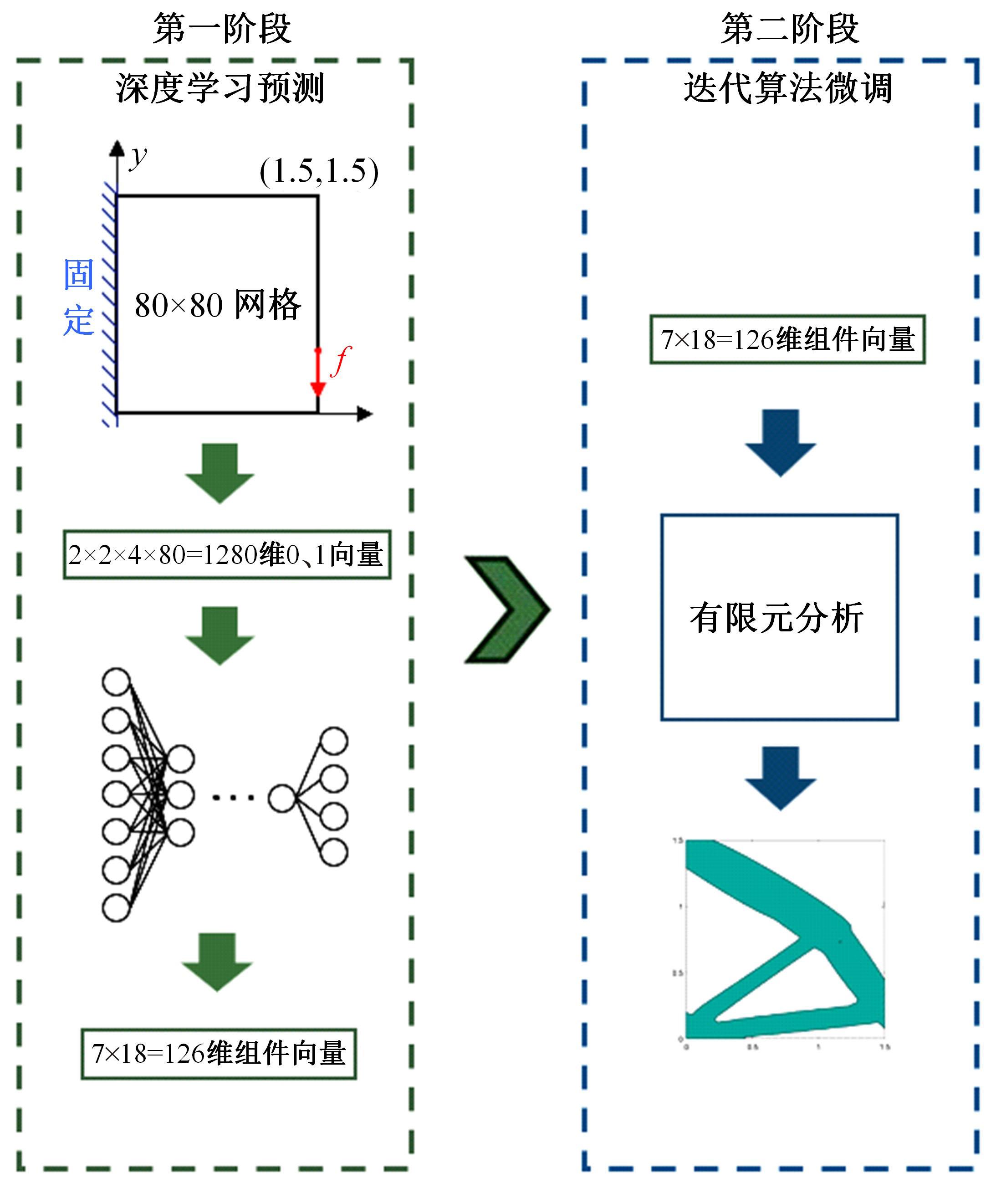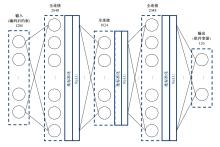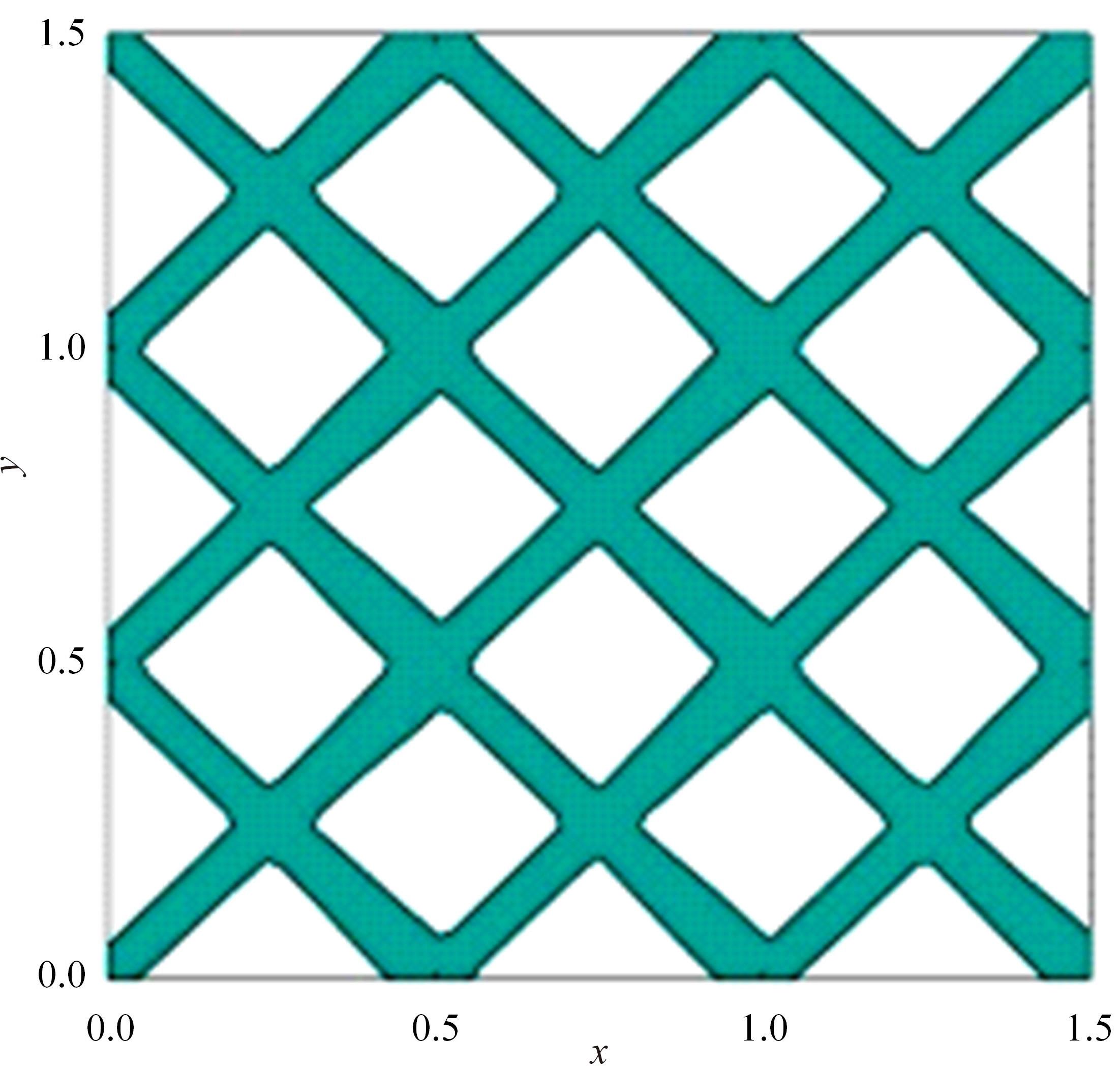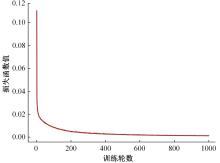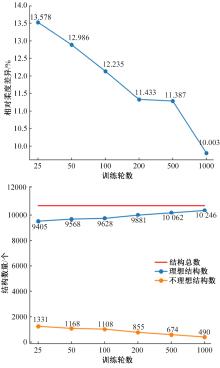Journal of Jilin University(Engineering and Technology Edition) ›› 2023, Vol. 53 ›› Issue (10): 2942-2951.doi: 10.13229/j.cnki.jdxbgxb.20220119
Previous Articles Next Articles
Deep-learning-based two-stage approach for real-time explicit topology optimization
Shu-yang SUN1,2( ),Wei-bin CHENG1,Hao-zhen ZHANG1,Xiang-ping DENG1,Hong QI1,2(
),Wei-bin CHENG1,Hao-zhen ZHANG1,Xiang-ping DENG1,Hong QI1,2( )
)
- 1.College of Computer Science and Technology,Jilin University,Changchun 130012,China
2.Key Laboratory of Symbolic Computation and Knowledge Engineering of Ministry of Education,Jilin University,Changchun 130012,China
CLC Number:
- TP399
| 1 | Bendsøe M P. Optimal shape design as a material distribution problem[J]. Structural Optimization, 1989, 1(4): 193-202. |
| 2 | Wang M Y, Wang X, Guo D. A level set method for structural topology optimization[J]. Computer Methods in Applied Mechanics and Engineering, 2003, 192(1/2):227-246. |
| 3 | Guo X, Zhang W, Zhong W. Doing topology optimization explicitly and geometrically—a new moving morphable components based framework[J]. Journal of Applied Mechanics, 2014, 81(8): No.081009. |
| 4 | Sosnovik I, Oseledets I. Neural networks for topology optimization[J]. Russian Journal of Numerical Analysis and Mathematical Modelling, 2019, 34(4): 215-223. |
| 5 | Yu Y, Hur T, Jung J, et al. Deep learning for determining a near-optimal topological design without any iteration[J]. Structural and Multidisciplinary Optimization, 2019, 59(3): 787-799. |
| 6 | Liu K, Tovar A, Nutwell E, et al. Towards nonlinear multimaterial topology optimization using unsupervised machine learning and metamodel-based optimization[C]∥International Design Engineering Technical Conferences and Computers and Information in Engineering Conference, Boston, USA, 2015. |
| 7 | Banga S, Gehani H, Bhilare S, et al. 3D topology optimization using convolutional neural networks[DB/OL].[2018-02-11]. . |
| 8 | Rawat S, Shen M H. A novel topology optimization approach using conditional deep learning[DB/OL]. [2019-03-14]. . |
| 9 | Lei X, Liu C, Du Z, et al. Machine learning-driven real-time topology optimization under moving morphable component-based framework[J]. Journal of Applied Mechanics, 2019, 86(1): No.011004. |
| 10 | Zhang W, Yuan J, Zhang J, et al. A new topology optimization approach based on moving morphable components (MMC) and the ERSATZ material model[J]. Structural and Multidisciplinary Optimization, 2016, 53(6): 1243-1260. |
| 11 | Hou W, Gai Y, Zhu X, et al. Explicit isogeometric topology optimization using moving morphable components[J]. Computer Methods in Applied Mechanics and Engineering, 2017, 326: 694-712. |
| 12 | Guo X, Zhao K, Wang M Y. A new approach for simultaneous shape and topology optimization based on dynamic implicit surface function[J]. Control Cybern, 2005, 34(1): 255-282. |
| 13 | Svanberg K. The method of moving asymptotes—a new method for structural optimization[J]. International Journal for Numerical Methods in Engineering, 1987, 24(2): 359-373. |
| [1] | Guang HUO,Da-wei LIN,Yuan-ning LIU,Xiao-dong ZHU,Meng YUAN,Di GAI. Lightweight iris segmentation model based on multiscale feature and attention mechanism [J]. Journal of Jilin University(Engineering and Technology Edition), 2023, 53(9): 2591-2600. |
| [2] | Ying HE,Zhuo-ran WANG,Xu ZHOU,Yan-heng LIU. Point of interest recommendation algorithm integrating social geographical information based on weighted matrix factorization [J]. Journal of Jilin University(Engineering and Technology Edition), 2023, 53(9): 2632-2639. |
| [3] | Yun-zuo ZHANG,Xu DONG,Zhao-quan CAI. Multi view gait cycle detection by fitting geometric features of lower limbs [J]. Journal of Jilin University(Engineering and Technology Edition), 2023, 53(9): 2611-2619. |
| [4] | Ming-yao XIAO,Xiong-fei LI,Rui ZHU. Medical image fusion based on pixel correlation analysis in NSST domain [J]. Journal of Jilin University(Engineering and Technology Edition), 2023, 53(9): 2640-2648. |
| [5] | Ya-hui ZHAO,Fei-yu LI,Rong-yi CUI,Guo-zhe JIN,Zhen-guo ZHANG,De LI,Xiao-feng JIN. Korean⁃Chinese translation quality estimation based on cross⁃lingual pretraining model [J]. Journal of Jilin University(Engineering and Technology Edition), 2023, 53(8): 2371-2379. |
| [6] | Xiao-jun JIN,Yan-xia SUN,Jia-lin YU,Yong CHEN. Weed recognition in vegetable at seedling stage based on deep learning and image processing [J]. Journal of Jilin University(Engineering and Technology Edition), 2023, 53(8): 2421-2429. |
| [7] | Xiang-jiu CHE,Huan XU,Ming-yang PAN,Quan-le LIU. Two-stage learning algorithm for biomedical named entity recognition [J]. Journal of Jilin University(Engineering and Technology Edition), 2023, 53(8): 2380-2387. |
| [8] | Qing-tian GENG,Zhi LIU,Qing-liang LI,Fan-hua YU,Xiao-ning LI. Prediction of soil moisture based on a deep learning model [J]. Journal of Jilin University(Engineering and Technology Edition), 2023, 53(8): 2430-2436. |
| [9] | Lian-ming WANG,Xin WU. Method for 3D motion parameter measurement based on pose estimation [J]. Journal of Jilin University(Engineering and Technology Edition), 2023, 53(7): 2099-2108. |
| [10] | Wei-tiao WU,Kun ZENG,Wei ZHOU,Peng LI,Wen-zhou JIN. Deep learning method for bus passenger flow prediction based on multi-source data and surrogate-based optimization [J]. Journal of Jilin University(Engineering and Technology Edition), 2023, 53(7): 2001-2015. |
| [11] | Pei-yong LIU,Jie DONG,Luo-feng XIE,Yang-yang ZHU,Guo-fu YIN. Surface defect detection algorithm of magnetic tiles based on multi⁃branch convolutional neural network [J]. Journal of Jilin University(Engineering and Technology Edition), 2023, 53(5): 1449-1457. |
| [12] | Zhen-hai ZHANG,Kun JI,Jian-wu DANG. Crack identification method for bridge based on BCEM model [J]. Journal of Jilin University(Engineering and Technology Edition), 2023, 53(5): 1418-1426. |
| [13] | Ze-qiang ZHANG,Wei LIANG,Meng-ke XIE,Hong-bin ZHENG. Elite differential evolution algorithm for mixed⁃model two⁃side disassembly line balancing problem [J]. Journal of Jilin University(Engineering and Technology Edition), 2023, 53(5): 1297-1304. |
| [14] | Wen-li JI,Zhong TIAN,Jing CHAI,Ding-ding ZHANG,Bin WANG. Prediction of water⁃flowing height in fractured zone based on distributed optical fiber and multi⁃attribute fusion [J]. Journal of Jilin University(Engineering and Technology Edition), 2023, 53(4): 1200-1210. |
| [15] | Peng YU,Yan PIAO. New method for extracting person re-identification attributes based on multi-scale features [J]. Journal of Jilin University(Engineering and Technology Edition), 2023, 53(4): 1155-1162. |
|
||



